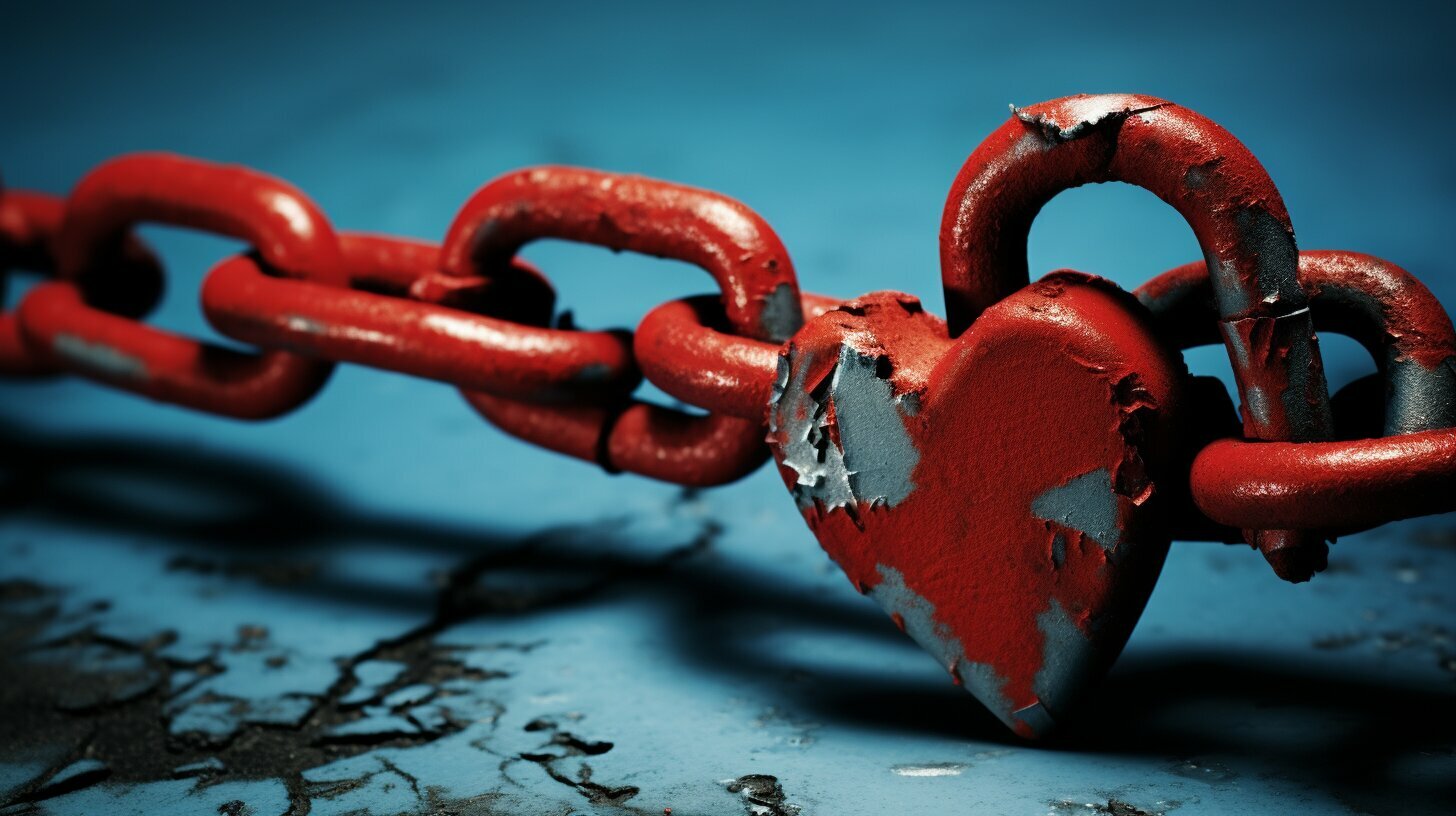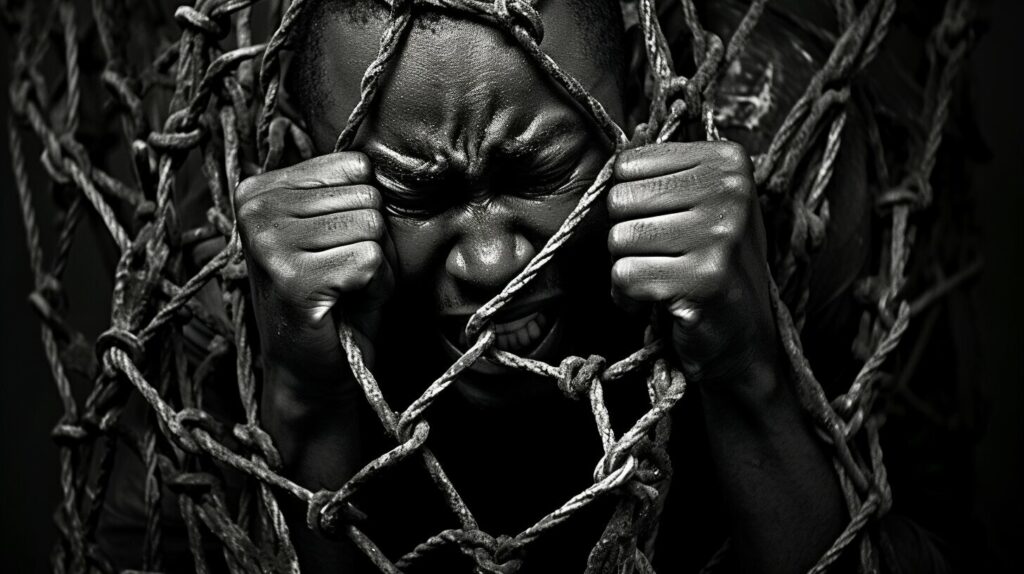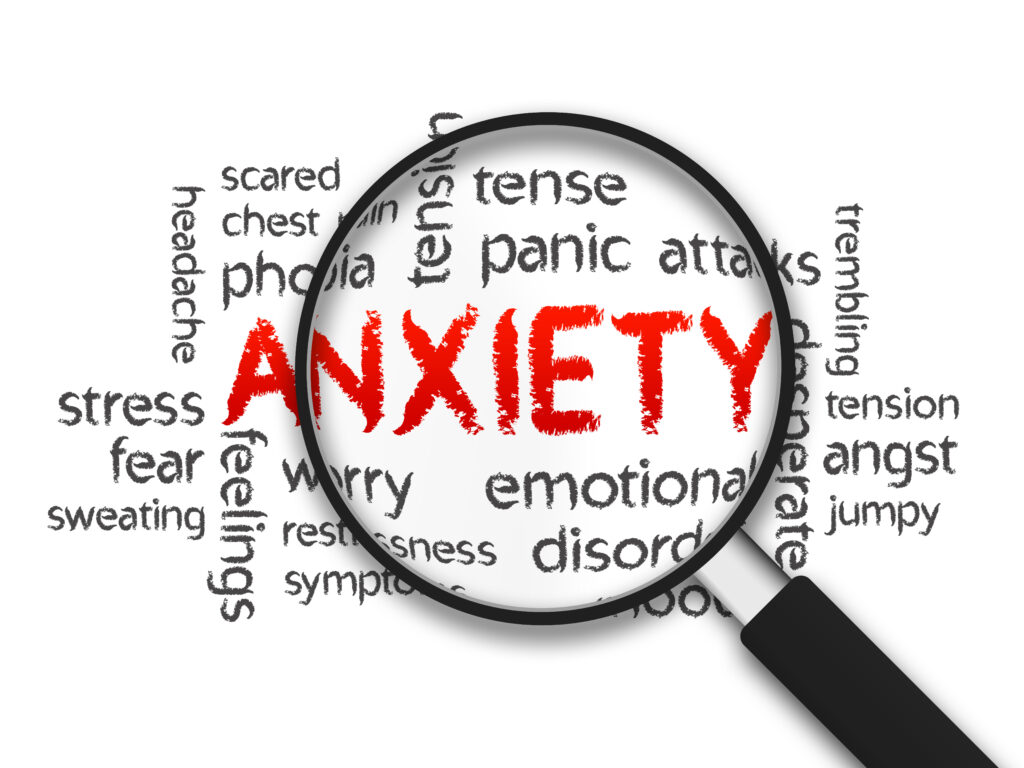Understanding Trauma Bonding: Breaking Unhealthy Bonds

Trauma bonding is a psychological concept that describes the unhealthy attachment between an abuser and their victim. It occurs when moments of distress and devaluation are juxtaposed with intermittent positivity, making it difficult for the victim to leave the toxic relationship. This type of attachment can exist in various dynamics with a power imbalance, such as domestic abuse, child abuse, narcissistic abuse, and more.
Victims of trauma bonding often exhibit signs of dependency on the abuser, defensiveness, rationalizing the abuser’s behaviors, isolation from friends and family, and self-blame. The brain, in an attempt to handle or survive trauma, develops this maladaptive coping strategy. Breaking free from a trauma bond requires acknowledging the truth about the abusive relationship, being vigilant about the situation, avoiding negative self-talk, and seeking professional support.
- Trauma bonding is an unhealthy attachment between an abuser and their victim.
- It occurs when moments of distress and devaluation are juxtaposed with intermittent positivity.
- Common signs of trauma bonding include dependency on the abuser, rationalizing their behaviors, and self-blame.
- Trauma bonding is a maladaptive coping strategy developed by the brain to handle or survive trauma.
- To break free from a trauma bond, it is important to acknowledge the truth, be vigilant, and seek professional support.
What is Trauma Bonding?
Trauma bonding refers to the unhealthy emotional and psychological attachment between an abuser and their victim. It occurs when moments of distress and devaluation are juxtaposed with intermittent positivity, creating a powerful bond that makes it incredibly challenging for the victim to leave the toxic relationship.
Emotional trauma bonding involves a deep connection that forms through a cycle of abuse and affection. The victim becomes conditioned to seek validation and love from the abuser, clinging onto the intermittent moments of kindness and affection. This creates a sense of hope that things will change, keeping them trapped in the cycle of abuse.
Psychological trauma bonding can occur in various dynamics with a power imbalance, such as domestic abuse, child abuse, narcissistic abuse, and more. These relationships often involve control, manipulation, and intimidation, further deepening the trauma bond.

Signs of Trauma Bonding
- Dependency on the abuser, relying on them emotionally, financially, or in other ways.
- Defensiveness, making excuses for the abuser’s actions and behaviors.
- Rationalizing the abuser’s behaviors, constantly trying to justify their actions.
- Isolation from friends and family, cutting off ties to maintain the abusive relationship.
- Self-blame, believing that the abuse is their fault or that they deserve it.
“Trauma bonding occurs when the victim is stuck between their fear of staying and their fear of leaving.”
Dr. Sherie Zander
Trauma bonding is a result of the brain’s maladaptive response to trauma, seeking familiarity and safety in the midst of abuse. Breaking free from a trauma bond requires acknowledging the truth about the abusive relationship and being vigilant about the patterns and dynamics at play. It is important to avoid negative self-talk and seek professional support to heal from the emotional and psychological effects of trauma bonding.
| 7 Stages of Trauma Bonding | Emotions/Behaviors |
|---|---|
| Idealization | Intense feelings of love, admiration, and trust towards the abuser. |
| Devaluation | Emotional and psychological abuse, creating fear, confusion, and self-doubt. |
| Guilt | Feeling responsible for the abuser’s actions and behaviors. |
| Normalization | Rationalizing the abusive behaviors, accepting them as normal. |
| Desensitization | Numbing of emotions, detachment, and a sense of helplessness. |
| Isolation | Withdrawing from friends and family, becoming more dependent on the abuser. |
| Escape/Hoovering | Moments of detachment from the abuser, followed by attempts to regain control. |
Trauma Bonding Signs
Recognizing the signs of trauma bonding is crucial for understanding the dynamics of an unhealthy attachment. Trauma bonding is a complex emotional response that occurs in toxic relationships, where the victim becomes emotionally and psychologically attached to their abuser. In order to break free from this cycle of abuse, it is important to identify the signs of trauma bonding.
One of the key signs of trauma bonding is a strong dependency on the abuser. The victim may feel unable to function without the presence or approval of their abuser, leading to an unhealthy reliance on them. This dependency can be emotional, financial, or even physical in nature.
Another sign is defensiveness and rationalization of the abuser’s behaviors. Victims of trauma bonding often find themselves making excuses for their abuser’s actions, downplaying the harm caused, or blaming themselves for the mistreatment. They may also isolate themselves from friends and family, feeling a sense of shame or fear of judgment.
Lastly, self-blame is a common characteristic of trauma bonding. The victim may internalize the abuse and believe that they deserve it or that it is their fault. This self-blame can further trap them in the cycle of trauma bonding, as they continue to justify and tolerate the abusive behavior.
To overcome trauma bonding, it is crucial for individuals to recognize these signs and seek support. Surrounding oneself with a strong support system, including friends, family, and professionals, can provide the necessary guidance and resources to break free from the unhealthy attachment and begin the healing process.

| Signs of Trauma Bonding |
|---|
| Dependency on the abuser |
| Rationalizing the abuser’s behaviors |
| Isolation from friends and family |
| Self-blame |
The Psychology Behind Trauma Bonding
Trauma bonding is a psychological response that the brain employs to cope with and survive trauma. It is a maladaptive coping strategy developed by the brain to handle intense and distressing experiences. Individuals who experience trauma bonding may find themselves trapped in toxic relationships, unable to break free despite the harm it causes them.
When faced with trauma, the brain goes into survival mode, seeking ways to protect itself. In the context of trauma bonding, this means forming a strong attachment to the abuser. This attachment is reinforced by intermittent rewards and moments of positivity amidst the abuse, creating a confusing and powerful bond.
“The trauma bond is like a twisted dance, where moments of pain are intertwined with fleeting moments of pleasure. The victim’s brain becomes wired to associate the abuser with safety and love, even though logically they know that the relationship is toxic,” explains Dr. Jane Roberts, a trauma therapist.
Understanding the psychology behind trauma bonding is essential in breaking free from its grip. By recognizing the maladaptive coping mechanisms at play, individuals can begin to challenge their beliefs and take steps towards healing and recovery.
As the brain becomes accustomed to the trauma bond, breaking free can be a challenging and complex process. It requires a combination of self-reflection, support, and professional guidance. By acknowledging the truth about the abusive relationship, individuals can start to unravel the psychological hold that trauma bonding has on them.
Being vigilant about the dynamics of the relationship is crucial. This includes recognizing the patterns of abuse, manipulation, and power imbalances that perpetuate the trauma bond. It also involves avoiding negative self-talk and self-blame, as these internal narratives can further reinforce the attachment to the abuser.
Seeking professional support is an essential component of the healing journey. Trauma therapists can provide a safe space for individuals to explore their experiences and emotions, while also offering guidance and tools to break free from trauma bonds. Support groups and online resources can also be valuable in connecting with others who have experienced similar trauma and finding shared strength and understanding.
In Summary
- Trauma bonding is a maladaptive coping strategy employed by the brain to handle and survive traumatic experiences.
- It creates a powerful attachment to the abuser, reinforced by intermittent moments of positivity amidst the abuse.
- Breaking free from trauma bonding requires acknowledging the truth, being vigilant about the dynamics, avoiding negative self-talk, and seeking professional support.
Breaking Trauma Bonds
Breaking trauma bonds requires a combination of self-awareness, support, and professional guidance. It is a challenging process that involves acknowledging the truth about the abusive relationship and being vigilant about the dynamics at play. It is important to remember that recovery from trauma bonding is possible, and there are strategies that can help individuals break free from unhealthy attachments.
One crucial step in breaking trauma bonds is to acknowledge the truth about the abusive relationship. This involves recognizing the harmful behaviors of the abuser and accepting that the relationship is toxic. It can be difficult to come to terms with this reality, as trauma bonding often involves moments of intermittent positivity that create confusion and a sense of attachment. However, acknowledging the truth is an essential first step towards healing.
Being vigilant about the dynamics at play is another key aspect of breaking trauma bonds. It is important to recognize the patterns of abuse and manipulation in the relationship. This includes identifying the tactics used by the abuser to maintain control and power over the victim. By becoming aware of these dynamics, individuals can better protect themselves and make informed decisions on how to move forward.
Seeking professional support is crucial in the healing process. Therapists and counselors who specialize in trauma recovery can provide guidance, validation, and tools to navigate the challenges of breaking trauma bonds. They can help individuals develop coping strategies, rebuild self-esteem, and establish healthy boundaries. Additionally, support groups or online communities can provide a sense of camaraderie and understanding as individuals work towards healing.
| Strategies for Breaking Trauma Bonds | Benefits |
|---|---|
| Seeking therapy or counseling | Professional guidance and support |
| Building a support network | Validation and understanding from others |
| Engaging in self-care activities | Rebuilding self-esteem and self-worth |
| Setting and enforcing boundaries | Regaining a sense of control and autonomy |
Breaking trauma bonds is a courageous journey towards healing and regaining one’s sense of self. It requires perseverance, self-compassion, and a commitment to prioritizing one’s well-being. Remember, you are not alone, and there is support available to help you break free from unhealthy bonds and create a life filled with love, respect, and empowerment.
Stages of Trauma Bonding
Trauma bonding involves a series of stages that outline the progression of the attachment between an abuser and their victim. These stages shed light on the complexities of trauma bonds and help individuals gain insight into the emotional and psychological aspects of their experiences. Understanding the stages can be a crucial step towards breaking free from a toxic relationship and embarking on a journey of healing and recovery.
The first stage is idealization, where the abuser presents themselves as loving, caring, and attentive. This stage establishes a foundation of trust and creates an emotional bond between the victim and the abuser. However, this idealized treatment is short-lived, leading to the second stage: devaluation. During this stage, the abuser starts to show their true colors, displaying abusive behaviors such as criticism, manipulation, and control. The victim is left confused and hurt, questioning their own worth and desperate to regain the initial affection.
The third stage is known as isolation, where the abuser intentionally separates the victim from their support system. By cutting off contact with friends and family, the abuser gains more control and power over the victim, making it increasingly difficult for them to leave the relationship. This is followed by the fourth stage: threats and intimidation. The abuser uses fear tactics to maintain their dominance, making the victim feel trapped and helpless.
The fifth stage is intermittent reinforcement, where the abuser oscillates between periods of cruelty and kindness. This creates emotional confusion for the victim, as they are unable to predict the abuser’s behavior and hold onto the hope of a return to the initial idealization. The sixth stage is known as bonding through shared experiences, where the victim finds solace in shared trauma, fostering a sense of connection and identity.
The final stage is the trauma bond, a state of deep attachment and dependency on the abuser. The victim becomes conditioned to the abusive behavior, and breaking free from the trauma bond can be an arduous process. It requires acknowledging the unhealthy attachment, seeking professional support, and implementing strategies for healing and recovery.
| Stages of Trauma Bonding | Description |
|---|---|
| Idealization | Abuser presents themselves as loving and caring. |
| Devaluation | Abuser reveals their true abusive nature. |
| Isolation | Abusers cut off the victim from their support system. |
| Threats and Intimidation | Abuser uses fear tactics to maintain control. |
| Intermittent Reinforcement | Abuser oscillates between cruelty and kindness. |
| Bonding Through Shared Experiences | The victim finds solace in shared trauma with the abuser. |
| Trauma Bond | Deep attachment and dependency on the abuser. |
Healing from Trauma Bonding
Healing from trauma bonding is a journey that requires self-care, therapy, and a strong support system. It is important for survivors to prioritize their well-being and take active steps towards breaking free from unhealthy attachments. Self-care plays a crucial role in the healing process, as it helps individuals rebuild their self-esteem and regain control over their lives.
Therapy can be a valuable tool in trauma bond recovery, providing a safe space for survivors to process their experiences and emotions. A qualified therapist can assist in addressing the underlying trauma, identifying patterns of behavior, and developing healthy coping mechanisms. Additionally, support systems are essential, whether it be through support groups or trusted friends and family members who can provide emotional support and validation.
It is crucial to remember that healing from trauma bonding is not a linear process. It takes time, patience, and self-compassion. Each individual’s journey is unique, and progress may fluctuate. Seeking professional help and relying on a support system can assist in navigating the challenges along the way.
| Key Points: | Strategies for Healing from Trauma Bonding: |
|---|---|
| 1. | Practice self-care to rebuild self-esteem and regain control. |
| 2. | Seek therapy to process emotions and develop healthy coping mechanisms. |
| 3. | Build a strong support system through support groups and trusted individuals. |
By prioritizing their well-being and utilizing available resources, survivors can embark on a journey towards healing and recovery from trauma bonding. Remember, you are not alone, and you deserve to live a life free from the chains of unhealthy attachments.
Finding Support and Resources
Finding support and resources is crucial for individuals seeking to recover from trauma bonding. Breaking free from unhealthy attachments requires a strong support system and access to professional help. Here are some avenues that can provide assistance and guidance on your journey towards healing.
Therapy
“Therapy is a safe space where you can explore your feelings, gain clarity, and learn coping mechanisms,” says Dr. Emily Roberts, a licensed therapist specializing in trauma recovery. Engaging in therapy allows you to work through the emotional and psychological effects of trauma bonding, providing you with the tools to rebuild your sense of self-worth and establish healthier boundaries in future relationships.
Support Groups
Joining a support group can be immensely helpful in connecting with others who have experienced trauma bonding. These groups offer a safe and non-judgmental space to share your experiences, gain insights from others, and receive validation and support. It’s a reminder that you are not alone and that others have successfully navigated similar challenges.
“Being part of a support group has been a lifeline for me,” shares Sarah, a survivor of trauma bonding. “Sharing my story and hearing others’ stories has given me strength and a sense of belonging.”
Online Resources
Online resources can serve as an additional source of support and information on trauma bond recovery. Websites, blogs, and forums dedicated to trauma healing can provide valuable insights, tips, and strategies for breaking free from unhealthy attachments. They can also offer a space for individuals to share their stories and connect with others on their healing journey.
| Resource | Description |
|---|---|
| PsychCentral | A comprehensive website offering articles, forums, and resources on trauma bonding and recovery. |
| SupportGroups.com | An online platform that hosts various support groups, including those focused on trauma bonding. |
| A subreddit community called r/traumabonds where individuals can share their experiences and find support. |
Remember, seeking support is a courageous step towards healing from trauma bonding. Whether through therapy, support groups, or online resources, these avenues can provide you with the assistance and understanding you need to break free from unhealthy bonds and embark on a path towards recovery.
Understanding Toxic Relationships
Toxic relationships are characterized by emotional abuse, power imbalances, and an unhealthy attachment between the abuser and the victim. These relationships can take various forms, such as romantic partnerships, family relationships, friendships, or professional dynamics. In a toxic relationship, one person exerts control and power over the other, often through manipulation, coercion, or physical violence.
Emotional abuse is a common feature of toxic relationships, where the victim is subjected to insults, criticism, humiliation, or belittlement. This constant emotional manipulation can lead to a diminished sense of self-worth, self-doubt, and a distorted perception of reality. The abuser may try to isolate the victim from their support network, making it difficult for them to seek help or escape the toxic environment.
Unhealthy attachment is another key aspect of toxic relationships. The victim may become emotionally dependent on the abuser, seeking validation and love despite the harmful behaviors. This attachment can create a cycle of trauma bonding, where moments of fear and pain are interspersed with intermittent affection and positive reinforcement. The victim may develop a strong attachment to their abuser, making it incredibly challenging to break free from the toxic relationship.
It is essential to recognize the signs of a toxic relationship to protect oneself from further harm. Some common indicators include constant criticism, gaslighting, controlling behaviors, lack of respect for boundaries, and a pervasive feeling of fear or unease. The victim may feel trapped, unable to leave the relationship due to fear of retaliation, financial dependence, or emotional attachment.
Understanding the dynamics of toxic relationships is crucial in order to break the cycle and seek help. Recognizing that it is not the victim’s fault and that they deserve to be treated with respect and kindness is the first step towards healing and recovery. By reaching out to trusted friends, family, or professionals, victims of toxic relationships can find the support and resources they need to break free and rebuild their lives.
| Toxic Relationship Signs | Impact on Victims |
|---|---|
| Constant criticism and belittlement | Low self-esteem and diminished self-worth |
| Gaslighting and manipulation | Doubt in one’s own perception of reality |
| Controlling behaviors and lack of respect for boundaries | Loss of autonomy and feelings of helplessness |
| Isolation from support networks | Feeling trapped and unable to seek help |
Breaking free from a toxic relationship takes courage, resilience, and support. It is important to remember that help is available, and no one deserves to be trapped in an unhealthy and abusive dynamic. By recognizing the signs, reaching out for support, and prioritizing one’s well-being, individuals can begin the journey towards healing, self-empowerment, and healthy relationships.
Conclusion
Breaking trauma bonds and healing from trauma bonding requires understanding, support, and a commitment to personal growth and well-being. Trauma bonding is an unhealthy attachment that develops between an abuser and their victim, where moments of distress and devaluation are juxtaposed with intermittent positivity, making it challenging for the victim to leave the toxic relationship.
Recognizing the signs of trauma bonding is crucial in breaking unhealthy bonds. Common indicators include dependency on the abuser, defensiveness, rationalizing the abuser’s behaviors, isolating oneself from loved ones, and self-blame. Understanding that trauma bonding is a maladaptive coping mechanism developed by the brain to handle or survive traumatic experiences is essential in the recovery process.
To break free from trauma bonds, it is important to acknowledge the truth about the abusive relationship and be vigilant about the dynamics at play. Avoid negative self-talk and seek professional support, such as therapy or support groups, to aid in the healing journey. Prioritizing self-care and surrounding oneself with a supportive network also contribute to the recovery from trauma bonding.
Remember that healing from trauma bonding takes time and may require ongoing support. By taking proactive steps towards understanding, seeking help, and prioritizing personal growth, individuals can break free from unhealthy bonds and embark on a journey of healing and recovery.
FAQ
Q: What is trauma bonding?
A: Trauma bonding is an unhealthy attachment between an abuser and their victim. It occurs when moments of distress and devaluation are juxtaposed with intermittent positivity, making it difficult for the victim to leave the toxic relationship.
Q: In what dynamics can trauma bonding occur?
A: Trauma bonding can exist in various dynamics with a power imbalance, such as domestic abuse, child abuse, narcissistic abuse, and more.
Q: What are the signs of trauma bonding?
A: Common signs of trauma bonding include dependency on the abuser, defensiveness, rationalizing the abuser’s behaviors, isolation from friends and family, and self-blame.
Q: Why does trauma bonding occur?
A: Trauma bonding occurs as a maladaptive way for the brain to handle or survive trauma.
Q: How can I break a trauma bond?
A: To break a trauma bond, it is important to acknowledge the truth, be vigilant about the situation, avoid negative self-talk, and seek professional support.
Subscribe to our newsletter.
Subscribe to our newsletter and join a supportive community dedicated to understanding, overcoming, and transforming personal trauma.
Related Articles
Understanding And Addressing Generational Trauma: Signs, Causes, And Healing Strategies
Breaking the Cycle: A Guide to Healing Generational and Intergenerational Trauma Feeling overwhelmed by unresolved issues and patterns plaguing your…...
12 Types of Anxiety Disorders
"Anxiety is the dizziness of freedom." - Søren Kierkegaard Anxiety disorders are more than just occasional…...
Dopamine addiction: How worried should you really be?
Dopamine Complex Role in Addiction Dopamine plays a complex and often misunderstood role in substance addiction…...
Exploring The Benefits Of Mindfulness And Body-Based Practices: A Comprehensive Guide
Introduction: Are you looking to improve your mental and physical health but don't know where to…...



